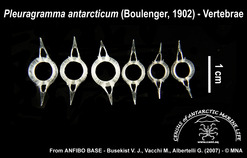
Species details
Ainley D.G., Wilson P.R., Barton K.J., Ballard G., Nur N. & Karl B. 1998. Diet and foraging effort of Adélie penguins in relation to pack-ice conditions in the Southern Ross Sea. Polar Biology 20, 311–319. Andriashev A.P. 1965. A general review of the Antarctic fish fauna. In: P. Van Oye & J. Van Mieghem (Eds.) Biogeography and ecology in Antarctica, Monographiae biologicae, Vol XV. The Hague: Junk Publications, 491–550. Burns J.M., Trumble S.J., Castellini M.A. & Testa J.W. 1998. The diet of Weddell seals in McMurdo Sound, Antarctica as determined from scat collections and stable isotope analysis. Polar Biology 19, 272–282. Casaux R.J., Barrera-Oro E.R., Favero M. & Silva P. 1998. New correction factors for the quantification of fish represented in pellets of the Imperial Cormorant Phalacrocorax atriceps. Marine Ornithology 26, 35–39. Casaux R., Baroni A. & Ramon A. 2003. Diet of Antarctic fur seals Arctocephalus gazella at the Danco Coast, Antarctic Peninsula. Polar Biology 26, 49–54. Cherel Y. & Kooyman G.L. 1998. The food of emperor penguins (Aptenodytes forsteri) in the Western Ross Sea (Antarctica). Marine Biology 130, 335–344. Creet S., Van Franeker J.A., Van Spanje T.M. & Wolff W.J. 1994. Diet of the pintado petrel Daption capense at King George Island, Antarctica, 1990-91. Marine Ornithology 22, 221–229. Daneri G.A. & Carlini A.R. 2002. Fish prey of Southern elephant seals, Mirounga leonina, at King George Island. Polar Biology 25, 739–743. DeWitt H.H. 1970. The character of the mid-water fish fauna of the Ross Sea, Antarctica. In: M.W. Holdgate (Ed.) Antarctic ecology, Vol. I, Academic Press, London, pp. 305–315. Eastman J.T. 1985, Pleuragramma antarcticum (Pisces, Nototheniidae) as food for other fishes in McMurdo Sound, Antarctica. Polar Biology 4, 155-160. Eastman J.T. 1999. Aspects of the biology of the icefish Dacodraco hunteri (Notothenioidei, Channichthyidae) in the Ross Sea, Antarctica. Polar Biology 21, 194–196. Fuiman L.A., Davis R.W. & Williams T.M. 2002. Behavior of midwater fishes under Antarctic ice: observations by a predator. Marine Biology 140, 815–822. Hubold G. 1991. Ecology of notothenioid fish in the Weddell Sea. In: G. Di Prisco, B. Maresca & B. Tota (Eds.) Biology of Antarctic fish. Springer, Berlin, pp. 3–22. Hubold G. & Tomo A.P. 1989. Age and growth of Antarctic silverfish Pleuragramma antarcticum Boulenger 1902 from the Southern Weddell Sea and Antarctic Peninsula. Polar Biology 9, 205-212. Kellermann A. 1986. On the biology of early life stages of notothenioid fishes (Pisces) off the Antarctic Peninsula. Ber. Polarforsch. 31, 1-149. Kock K.H. & Kellerman A. 1991. Reproduction in Antarctic notothenioid fish. Antarctic Science 3, 125–150. La Mesa M., Vacchi M., Castelli A. & Diviacco G. 1997. Feeding ecology of two nototheniid fishes, Trematomus hansoni and Trematomus loennbergii, from Terra Nova Bay, Ross Sea. Polar Biology 17, 62–68. La Mesa M., Dalù M. & Vacchi M. 2004. Trophic ecology of emerald notothen Trematomus bernacchii (Pisces, Nototheniidae) from Terra Nova Bay, Ross Sea. Polar Biology 27, 721–728. Lauriano G., Vacchi M., Ainley D. & Ballare G. 2007. Observations of top predators foraging on fish in the pack ice of the Southern Ross Sea. Antarctic Science 19(4), 439-440. Lowry L.F., Testa J.W. & Calvert W. 1988. Notes on winter feeding of crabeater and leopard seals near the Antarctic Peninsula. Polar Biology 8, 475–478. Vacchi M., La Mesa M., Dalu M. & MacDonald J. 2004, Early life stages in the life cycle of Antarctic silverfish Pleuragramma antarcticum in Terra Nova Bay, Ross Sea. Antarctic Science 3, 299 – 305.






